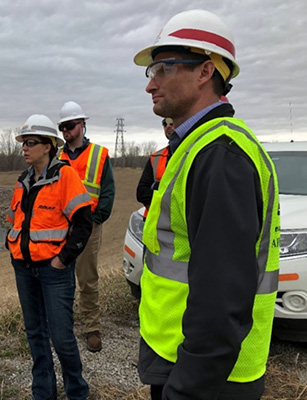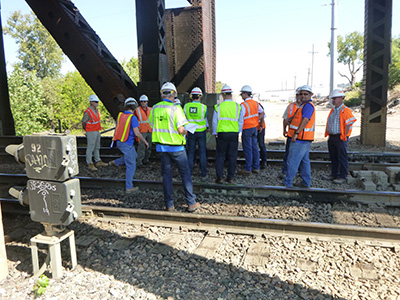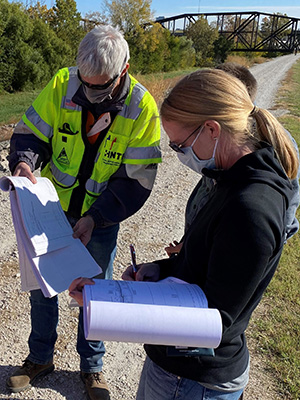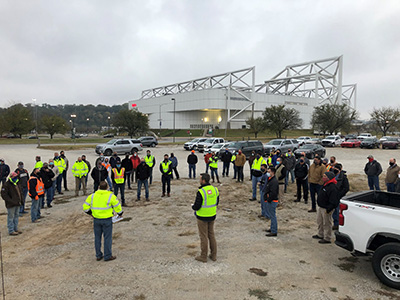 Paul Muller, Kansas City District structural engineer and BNSF engineers reviewing the upstream Argentine Levee Unit closure structure.
Paul Muller, Kansas City District structural engineer and BNSF engineers reviewing the upstream Argentine Levee Unit closure structure.The Kansas Citys Levees Project stands out as one of the largest and most complex ever undertaken by the Kansas City District, with life-safety and economic benefits to match.
“The team’s dedication to exceed requirements for scope, cost, schedule, and quality are accelerating the delivery of this high-profile project. Team members demonstrate the Corps of Engineers vision of “Engineering solutions for the nation’s toughest challenges,” said Col. Bill Hannan, commander, Kansas City District.
The $529 million KC Levees project will raise approximately 17 miles of levees and floodwalls along the Argentine, Armourdale, and Central Industrial District – known as CID – levee units. The design calls for 28,000 feet of new, modified, and replacement floodwalls, levees and underseepage berms requiring nearly one million cubic yards of earthwork, 130 new relief wells, replacement of 12 high-traffic railroad stoplog or sandbag gap closures, drainage structure improvements, relocation of dozens of utilities, two pump station replacements, and 11 pump station repairs.
When completed, the Kansas Citys Levees system will provide improved reliability and resiliency and reduce the likelihood of overtopping by 200%. Nearly 27,000 residents will benefit from the improvements in life safety considerations. There are also economic benefits regionally and nationally. The system benefits nearly $10B of nationally significant manufacturing, warehouses, and transportation distribution centers. The leveed area is home to one of the largest railroad hubs in the nation, with rail yards and tracks owned and operated by Kansas City Terminal, Burlington Northern Santa Fe, Union Pacific, and Kansas City Southern. Collectively, these businesses provide tens of thousands of jobs.
 Personnel from Kansas City District, HNTB architecture firm, and the Kansas City Terminal Railroad reviewing a closure structure along the Central Industrial District Levee Unit.
Personnel from Kansas City District, HNTB architecture firm, and the Kansas City Terminal Railroad reviewing a closure structure along the Central Industrial District Levee Unit.To tackle a project of this size and importance, the Kansas City District has built remarkably strong working partnerships at every step, beginning with the local non-federal partners: the Unified Government of Wyandotte County and Kansas City Kansas, the City of Kansas City, Missouri, and Kaw Valley Drainage District. From the project team, to affected landowners, railroads and other stakeholders, the attention to strong working relationships has had measurable impacts on the quality and speed of decision making and overall chemistry between the Kansas City District and the stakeholders.
Given the size and complexity of the design and construction process, the Kansas City District partnered with numerous Architect/Engineering firms that could strategically apply their human resources and technical capabilities to meet the aggressive project schedule with the goal of moving dirt faster. This is consistent with the Revolutionize USACE Civil Works goal to start and finish projects faster. Segmenting over 200 engineers, geologists, specialists, construction managers, and project managers from around the nation into multiple design teams posed challenges. But all team members embraced a common vision to deliver this complex project through the strategic use of innovative design and construction acquisition strategies, disciplined application of risk-informed decision-making methods and finding innovative solutions for complex technical challenges.
Kansas City District subject matter experts were embedded with the architects-engineers to empower teams to make important day to day decisions to mitigate quality risks and ensure the efforts were seamless. By making USACE expertise a constant presence during the design phase, engineering judgements received immediate review, and quality assurance procedures were continuously applied so that USACE quality criterion were consistently applied. The continuous flow of information among the team supported application of risk informed decision making principles, with all activities assuring that the life-safety considerations for the community were paramount.
 Katrina Marx, Kansas City District structural engineer and technical lead for the Armourdale and Central Industrial District Levee units, and Carl Schipfmann, HNTB structural engineer, review plans during the 95% plan-in-hand site visit along the Armourdale Levee Unit.
Katrina Marx, Kansas City District structural engineer and technical lead for the Armourdale and Central Industrial District Levee units, and Carl Schipfmann, HNTB structural engineer, review plans during the 95% plan-in-hand site visit along the Armourdale Levee Unit.Design and construction pose many challenges including historic raises and improvements, complex subsurface conditions, contaminated sites, narrow work areas, railroads adjacent to the levees, 75-year old pump stations, and 150 years of industrial development.
The team utilized innovative design techniques including constructing new floodwalls behind existing to significantly reduce flood risk during construction, developed an analytical evaluation tool to determine if existing structures required modification, created a comprehensive construction sequence model with over 3,000 entries, incorporated semi-quantitative risk assessment and cost and schedule risk analysis findings into the plan and product documents, and utilized a rarely used Two-Step Invitation for Bid acquisition strategy. These techniques mitigated potentially $250 million in cost and schedule risks.
Early on, the team identified that real estate acquisition posed high risks to the project’s success. Therefore, the team purposefully established open lines of communication with landowners on approximately 125 parcels adjacent to the levees. Through numerous virtual and in-person meetings, the team worked hard to understand the needs of each landowner by analyzing each parcel to provide design solutions that reduced impacts on landowners while mitigating acquisition risks. Landowners gained confidence in the team, leading to more productive negotiations, and speaking openly about their appreciation of being included in the design process.
Another high risk was the challenge of designing and coordinating 12 critical levee closure structures across the mainline and switching tracks for Union Pacific, BNSF, and Kansas City Terminal railroads. The team knew it was paramount to find alternatives that would lessen operational impacts on this major rail hub during and after construction. Each closure required analysis of multiple locations, foundation treatments, and phasing plans to minimize impacts. Once again, the project team’s attention to working relationships created positive outcomes.
The team broke new ground by establishing collaborative partnerships with the railroads. Opening lines of communication was essential to understanding their operational needs then finding mutually acceptable solutions that accounted for those needs. The results were synergetic designs eliciting fewer comments, review schedules reduced by years, and minimization of operational impacts from the project.
 Jay Denker, Kansas City District contracting officer, and Scott Mensing, Kansas City District levees program manager, provide introductory statements to contractors during the Step 1 site visit for the Argentine, Armourdale, and Central Industrial District Levee Raise contract.
Jay Denker, Kansas City District contracting officer, and Scott Mensing, Kansas City District levees program manager, provide introductory statements to contractors during the Step 1 site visit for the Argentine, Armourdale, and Central Industrial District Levee Raise contract.Through 18 months of market research, communications, and outreach presentations, the team turned its attention to developing strong relationships with industry. The team maintained frequent communications with contractors, seeking to better understand industry’s risks related to contracting.
This feedback was reflected in the final acquisition strategy, plans, and specifications. Adjustments included combining the levee raise packages into a single contract to increase value and establishment of fair, yet restrictive, selection processes, utilizing a rarely used Two-Step Invitation for Bid, acquiring design/build services for pump station replacements, and targeting pump station repairs to the small business community. The team’s effort bore fruit: contractor feedback and enthusiasm exceeded expectations which led to increased competition for each segment of this very complex project.
As the team transitions from the design phase into construction, the relationships established will continue to pay dividends. By explicitly incorporating the needs of utility owners, local governments, railroads, and private property owners in its solutions, the team demonstrated its commitment to managing the community’s flood risk, moderating the impact of the project’s footprint, and providing significant benefits.